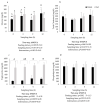The Interplay between Central and Peripheral Systems in Feed Intake Regulation in European Seabass (Dicentrarchus labrax) Juveniles
- PMID: 36496811
- PMCID: PMC9739057
- DOI: 10.3390/ani12233287
The Interplay between Central and Peripheral Systems in Feed Intake Regulation in European Seabass (Dicentrarchus labrax) Juveniles
Abstract
The present study aimed to evaluate the effects of feeding or feed deprivation on the orexigenic and anorexigenic responses at the central (whole brain) and peripheral (anterior and posterior intestine, stomach, and liver) system levels in European seabass. For this purpose, a group of fish (208 g) was fed a single meal daily for 8 days (fed group) and another group was feed-deprived for 8 days (unfed group). Compared to the fed group, in the whole brain, feed deprivation did not induce changes in npy, agrp1, and cart2 expression, but increased agrp2 and pomc1 expression. In the anterior intestine, feed deprivation increased cck expression, while in the posterior intestine, the npy expression increased and pyyb decreased. In the stomach, the ghr expression decreased regardless of the feeding status. The hepatic lep expression increased in the unfed fish. The present results suggest a feed intake regulation mechanism in European seabass similar to that observed in other teleosts.
Keywords: anorexigenic; fasting; feeding; orexigenic.
Conflict of interest statement
The authors declare no conflict of interest. The funders had no role in the design of the study; in the collection, analyses, or interpretation of data; in the writing of the manuscript, or in the decision to publish the results.
Figures





Similar articles
-
Solid-State Fermentation of Plant Feedstuff Mixture Affected the Physiological Responses of European Seabass (Dicentrarchus labrax) Reared at Different Temperatures and Subjected to Salinity Oscillation.Animals (Basel). 2023 Jan 24;13(3):393. doi: 10.3390/ani13030393. Animals (Basel). 2023. PMID: 36766282 Free PMC article.
-
Blood chemistry profile as indicator of nutritional status in European seabass (Dicentrarchus labrax).Fish Physiol Biochem. 2014 Oct;40(5):1339-47. doi: 10.1007/s10695-014-9928-5. Epub 2014 Mar 20. Fish Physiol Biochem. 2014. PMID: 24647468
-
Feedback from Arctic charr: Feed flavour stimulation and re-feeding after feed deprivation stimulate genes encoding both orexigenic and anorexigenic neuropeptides.Gen Comp Endocrinol. 2017 May 15;246:71-80. doi: 10.1016/j.ygcen.2017.03.012. Epub 2017 Mar 19. Gen Comp Endocrinol. 2017. PMID: 28327432
-
Disease resistance and response against Vibrio anguillarum intestinal infection in European seabass (Dicentrarchus labrax) fed low fish meal and fish oil diets.Fish Shellfish Immunol. 2017 Aug;67:302-311. doi: 10.1016/j.fsi.2017.06.022. Epub 2017 Jun 7. Fish Shellfish Immunol. 2017. PMID: 28602741
-
Black soldier fly (Hermetia illucens) larvae meal in diets of European seabass: Effects on antioxidative capacity, non-specific immunity, transcriptomic responses, and resistance to the challenge with Vibrio alginolyticus.Fish Shellfish Immunol. 2021 Apr;111:111-118. doi: 10.1016/j.fsi.2021.01.013. Epub 2021 Jan 25. Fish Shellfish Immunol. 2021. PMID: 33508473
Cited by
-
Identification of Three POMCa Genotypes in Largemouth Bass (Micropterus salmoides) and Their Differential Physiological Responses to Feed Domestication.Animals (Basel). 2024 Dec 17;14(24):3638. doi: 10.3390/ani14243638. Animals (Basel). 2024. PMID: 39765543 Free PMC article.
References
-
- Food and Agriculture Organization of the United Nations . The State of the World Fisheries and Aquaculture-Meeting the Sustainable Development Goals. Volume 50. FAO; Rome, Italy: 2022. pp. 50–5350. - DOI
-
- Hasan M.R. Feeding Global Aquaculture Growth. FAO Aquac. Newsl. 2017;56:2–3.
-
- Volkoff H., Canosa L.F.F., Unniappan S., Cerdá-Reverter J.M.M., Bernier N.J.J., Kelly S.P.P., Peter R.E.E. General, and Comparative Endocrinology. Volume 142. Academic Press Inc.; Cambridge, MA, USA: May 15, 2005. Neuropeptides and the Control of Food Intake in Fish; pp. 3–19. - PubMed
Grants and funding
- NORTE-01-0145-FEDER-000040/ATLANTIDA - Platform for the monitoring of the North Atlantic Ocean and tools for the sustainable exploitation of the marine resources
- NORTE-01-0145-FEDER-000064/Ocean3R, supported by the North Portugal Regional Operational Programme (NORTE2020), under the PORTUGAL 2020 Partnership Agreement and through the European Regional Development Fund (ERDF).
- SFRH/BD/137919/2018/FCT
LinkOut - more resources
Full Text Sources
Miscellaneous

